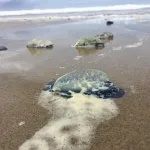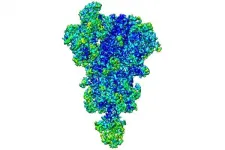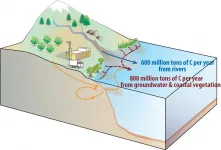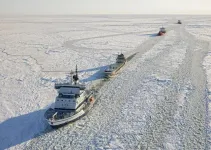Sheep vs. goats: Who are the best problem solvers?
2021-03-18
(Press-News.org) When it comes to adapting to new situations, goats are a step ahead. Compared to sheep, they can more quickly adapt to changing environmental conditions. These are the findings of a new study by researchers at Martin Luther University Halle-Wittenberg (MLU) and the Leibniz Institute for Farm Animal Biology (FBN) which were published in Royal Society Open Science. The study investigated how well the animals were able to navigate around obstacles to reach food.
Sheep and goats have many things in common: They are closely related genetically, roughly the same size, have similar social structures, and have both been domesticated by humans over approximately the same amount of time. They do, however, differ greatly when it comes to their foraging strategies. "While sheep are grazers, goats are browsers and prefer buds and fresh shoots," explains Dr Camille Raoult from MLU who led the study together with Dr Christian Nawroth from FBN. The experiments were conducted at the Agroscope research centre in Switzerland, at Queen Mary University London (QMUL) and the Buttercups Sanctuary for Goats in Kent.
"It is important that animals are able to react swiftly to a changing environment because this allows them to find and exploit new food sources," says Nawroth. The team therefore wanted to investigate how both animal species react to new spatial obstacles. The experimental set-up of the study was rather straightforward: one animal at a time was led to the end of a small enclosure. Another person stood at the opposite end offering food. In between was a fence with a gap - the direct path was blocked each time. The researchers observed the animals' behaviour, specifically, whether they moved directly towards the gap, and recorded the time it took them to reach the food. After a few rounds, the position of the gap in the fence was changed. The animals then repeated the test. A total of 21 goats and 28 sheep completed the experiment.
The results: In the first round with the newly located gap, the goats managed to walk around the obstacle easier and faster, although the sheep reached their goal faster on average. Both the sheep and goats were initially puzzled by the new position of the gap and needed a few attempts to adjust to the new situation. Afterwards, they made fewer mistakes. The experiments could not be carried out under identical conditions at both locations, but the results were nevertheless clear: "Goats appear to adapt better and more accurately to new situations and move with less perseveration around the obstacle when the gap has changed. This suggests that they are more cognitively flexible than sheep," says co-author Dr Britta Osthaus from Canterbury Christ Church University in summary. One possible reason for the differences could be their different foraging strategies, the researcher adds.
INFORMATION:
The study was supported by the Swiss Federal Food Safety and Veterinary Office, the Deutsche Forschungsgemeinschaft (DFG, German Research Foundation) and the US animal welfare organization Farm Sanctuary.
Study: Raoult C. M. C. et al. Goats show higher behavioural flexibility than sheep in a spatial detour task. Royal Society Open Science (2021). Doi: 10.1098/rsos.201627
https://royalsocietypublishing.org/doi/10.1098/rsos.201627
[Attachments] See images for this press release:
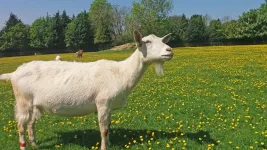
ELSE PRESS RELEASES FROM THIS DATE:
2021-03-18
As their name suggests, by-the-wind sailor jellyfish know how to catch a breeze. Using a stiff, translucent sail propped an inch above the surface of the ocean, these teacup-sized organisms skim along the water dangling a fringe of delicate purple tentacles just below the surface to capture zooplankton and larval fish as they travel.
At the mercy of the wind, these jellies can wash ashore and strand -- sometimes numbering in the trillions -- on beaches around the world, including up and down the U.S. West Coast. And while these mass stranding events are hard to miss, very little actually is known about how or why they happen.
Now, thanks to 20 years of observations from thousands of citizen scientists, ...
2021-03-18
When it comes to the use of driverless vehicles, an individual's support for their adoption hinges on how safe they are, rather than their economic impact or privacy concerns stemming from the data they might collect, a Nanyang Technological University, Singapore (NTU Singapore) study of 1,006 Singaporeans has found.
The NTU Singapore study led by the Wee Kim Wee School of Communication and Information exposed its participants to positive and negative blog posts about driverless vehicles and their safety, their impact on jobs and the economy, ...
2021-03-18
The collaborative work is published online in the journal Communications Biology on March 8th, 2021.
The power of photosynthesis
Photosynthesis represents the only biological process, which converts the energy of sunlight into chemically stored energy. On molecular level, the photosynthetic key enzymes called photosystems are responsible for this conversion process. Photosystem I (PSI), one of the two photosystems, is a large membrane protein complex that can be present in different forms - as monomers, dimers, trimers or even tetramers.
New isolation technique helps revealing ...
2021-03-18
An international team of scholars studied how the COVID-19 pandemic has impacted Europeans' stress levels and their trust in their national governments and the healthcare systems. They found that respondents were most stressed by the state of the national economy, and only after that, by the risk of catching COVID-19 and possibly being hospitalized. The results of the study were published in Royal Society Open Science.
The authors of the study represent over 50 universities. Among them is Dmitrii Dubrov, Junior Research Fellow at the HSE Center for Sociocultural Research, who developed and organized the global survey, COVIDiSTRESS. The researchers studied the psychological ...
2021-03-18
An international study led by the University Complutense of Madrid (UCM) proposed new computational image processing methods that improve the analysis and three-dimensional reconstruction of biological macromolecules.
Currently, determining the composition (i.e., the sequence of amino acids) of macromolecules such as proteins is relatively simple; however, determining the shape in which they are ordered in a three-dimensional structure is not. The new methodology, published in Nature Communications, improves the visualization of the 3D reconstructions obtained through cryogenic electron microscopy, as well as their quality.
"This study helps us broaden our understanding of proteins ...
2021-03-18
Every year 600-900 million tons of carbon flow through rivers to the ocean either as particles or in dissolved form. Researchers have known for a long time that this does not represent the total amount of carbon that gets transported from the land to the ocean. But the remaining contributors mostly from coastal ecosystems, such as carbon-rich mangrove forests, and from groundwater discharge into the ocean have been notoriously difficult to measure.
A new study published in the journal Global Biogeochemical Cycles and spearheaded by Dr. Eun Young Kwon, project leader at the IBS Center for Climate Physics South Korea provides new estimates of this elusive component of the global carbon cycle. The study makes use of the existence of two stable carbon isotopes, 12C and 13C, with the latter ...
2021-03-18
Statisticians have calculated the probability of ships of different Polar Ship Categories becoming beset in ice along the Northern Sea Route. Their data will help assess the risks of maritime traffic in the Arctic.
The results of the new study, published recently in the Cold Regions Science and Technology journal, will support safer maritime transport planning and the prevention of oil spills. The results will also benefit authorities that regulate maritime traffic by providing a foundation for statutes and legislation. A comprehensive approach to computing helps shipping companies plan transport routes.
Tankers more common on the Northern Sea Route
The Northern Sea Route is attracting more tankers and cargo ships travelling from Russia and ...
2021-03-18
Powerful and squat stegosaurs are now one of the most recognisable dinosaurs: they are easily identified by the spines on the tail and the bony plates on the back - osteoderms. The representatives of this group lived about 165-125 million years ago, during the Jurassic and early Cretaceous periods. They were five to seven metres long and had a disproportionately small head. Their teeth were therefore quite small - about a centimetre in height and about the same in width.
Palaeontologists from St Petersburg University worked together with colleagues from: the Zoological Institute of the Russian Academy of Sciences; the ...
2021-03-18
The ocean covers about 70% of the Earth's surface area and is the largest reservoir of energy. Researchers have been exploring the approach for harnessing ocean energy to solve the world energy crisis and pollution problems caused by thermal power generation. The nanogenerator, including piezoelectric, triboelectric, and pyroelectric nanogenerators, is one of the key technologies for mechanical energy conversion. The triboelectric nanogenerator (TENG) makes use of the triboelectric effect and electrostatic induction to harvest mechanical energy based on contact or sliding electrification.
However, conventional TENG device is often based on solid/solid contact, and it is hard to ensure the contact intimacy of the two tribo-materials. In the meanwhile, the material surfaces will wear or become ...
2021-03-18
Research from the University of Kent's School of Biosciences has revealed that a molecule produced by the human immune system can severely diminish the potency of certain antibiotics.
This may explain why antibiotics effective in laboratory settings can be less effective at clearing infections in humans.
The research findings, which have been published in the journal Archives of Microbiology, reveal that nitric oxide, a molecule produced by our immune systems, can render aminoglycoside antibiotics ineffective when used against E. coli strains isolated from ...
LAST 30 PRESS RELEASES:
[Press-News.org] Sheep vs. goats: Who are the best problem solvers?

